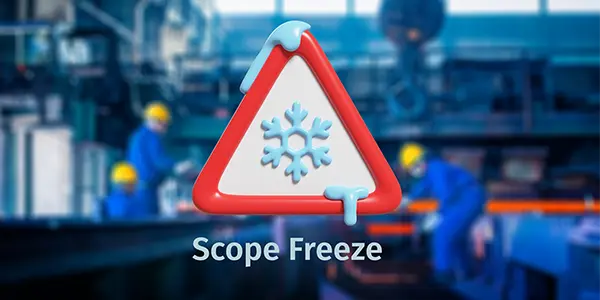
Turnarounds (TARs) are some of the most complex and high-stakes events in the lifecycle of an industrial facility. Whether it’s a refinery, chemical plant, or manufacturing unit, a turnaround involves a full or partial shutdown of operations to perform inspections, maintenance, upgrades, or repairs. These events are inherently expensive, both in direct costs and lost production. One of the key pillars that separates a successful turnaround from a chaotic, over-schedule, over-budget one is the scope freeze.
What is a scope freeze in turnarounds?
A scope freeze is a formal point in the turnaround planning phase where no new work is added to the execution scope anymore. After this point, the team focuses entirely on detailed planning, procurement, and resource alignment for the defined worklist. In essence, scope freeze draws a line in the sand: “This is what we’re going to do, and nothing more.”
Why is a scope freeze so important?
Without a well-defined and frozen scope, turnarounds can spiral out of control. Here’s why scope freeze matters:
1. Budget control
Every new work item added late in the game has cost implications — labor, materials, equipment, and potentially delayed startup. Without clear decision gates and scope discipline, this can easily lead to scope creep, undermining both budget and focus.
2. Schedule discipline
New scope means more work to plan, more permits, more interfaces, and more opportunities for delays. Freezing the scope allows planners and schedulers to develop a reliable execution plan that aligns with the shutdown window.
3. Resource allocation
Labor, tools, and materials are planned based on a specific scope. Sudden additions can cause shortages, overtime, or reallocation that impacts critical path activities.
4. Risk Mitigation
Late scope changes often bypass proper risk assessments and hazard reviews, increasing the potential for safety incidents or quality issues.
In most organizations, scope freeze happens 6–12 months before the turnaround execution, depending on the complexity and size of the event.
Managing emergencies and discoveries after scope freeze
While scope freeze is firm, it should not be rigid. True emergency work, typically HSE or regulatory-driven, must still be accommodated. The key is to distinguish between emergencies and inconvenient timing. This is where the scoping team adds value: they filter out “nice-to-have” items and only allow in truly critical work.
Final thoughts
Freezing the scope isn’t about limiting flexibility, it’s about ensuring execution excellence. In the world of turnarounds, where the margin for error is razor-thin, discipline in scope management is a hallmark of high-performing organizations.
The next time you’re preparing for a TAR, remember: the freeze isn’t the end of planning. It is the beginning of focused execution.
Need to improve scope control and turnaround outcomes?
Explore how Cleopatra Enterprise’s turnaround management software puts you in control of the entire process from start to finish. Alternatively, contact our team to discuss how we can support your next TAR.
Shutdowns, Turnarounds and Outages (STO) events often involve project scope, which introduces many challenges. Especially meeting event schedules.…
When it comes to managing Shutdowns, Turnarounds, and Outages (STOs), finding the right local partner can be a…
Related resources

The responsibilities of a Cost Engineer in STO preparation
Learn the vital responsibilities of cost engineers in planning STO projects, balancing budgets, managing risks, and more.
Read blog article
What are Shutdowns, Turnarounds, and Outages (STOs)?
Discover what shutdowns, turnarounds, and outages (STOs) are, why they matter, key challenges, and best practices for effective STO management.
Read blog article